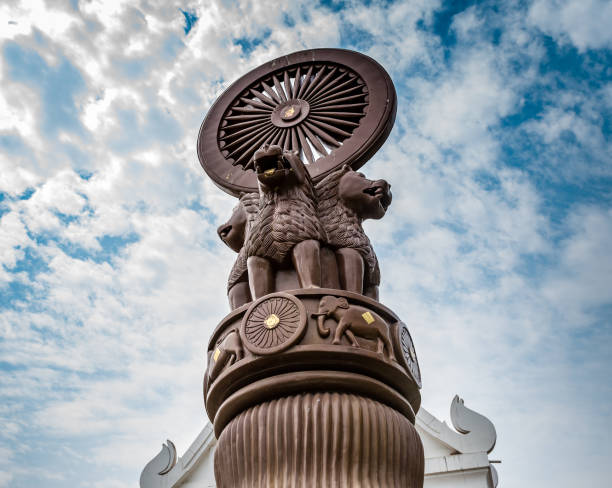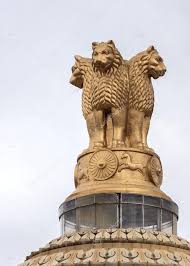The construction of the new Parliament building was a monumental undertaking, involving a multitude of on-site and off-site activities. As the eagerly anticipated ceremonial inauguration of the new building approaches, it becomes apparent that every corner of this magnificent complex embodies the essence of India’s rich cultural heritage, with each element sourced from different states across the country.
While the on-site construction activities were colossal in scale, the off-site tasks played a pivotal role in shaping the new Parliament. Materials procured from various states, including Tripura, Uttar Pradesh, Rajasthan, and others, have contributed to the creation of this architectural marvel. Let’s delve into the details of what comes from where in the making of the new Parliament:
A Kaleidoscope of Unity: The New Parliament Showcases India’s Diverse Origins
Resonating with the grandeur of iconic structures like the Red Fort and Humayun’s Tomb in Delhi, the sandstone used in the construction was sourced from Sarmathura, Rajasthan. Its regal presence adds a touch of magnificence to the building’s exterior.
Inside the Lok Sabha chamber, one can find the majestic Kesharia green stone, sourced from the enchanting city of Udaipur in Rajasthan. This stone exudes a sense of tranquility and grace, reflecting the solemnity of the lower House. In contrast, the Rajya Sabha chamber boasts the elegance of red granite, which hails from the historic city of Ajmer in Rajasthan. These stones, along with the white marbles from Ambaji in Rajasthan, lend a captivating aura to the inner sanctums of the Parliament.
The timeless beauty of teakwood, known for its durability and elegance, was procured from Nagpur, Maharashtra. This exquisite wood has been meticulously crafted to create the furniture that adorns the Parliament’s interiors, providing both comfort and sophistication.
The fine artistry displayed in the furniture was brought to life in Mumbai, where skilled craftsmen poured their expertise into every piece. Their meticulous craftsmanship is evident in the intricate details and impeccable finishes, enhancing the overall aesthetic appeal of the Parliament.
The lattice work, delicately adorning the stone surroundings of the building, originates from the artistic hands of craftsmen from Rajasthan, Noida, and Uttar Pradesh. These masterpieces of stone craftsmanship add a touch of intricacy and charm to the architectural design, symbolizing the fusion of creativity and tradition.
The false ceiling structures, meticulously engineered using steel, were procured from the enchanting locales of Daman and Diu. These structures not only provide structural integrity but also create a sense of grandeur within the Parliament’s halls.
The Ashoka Emblem, a symbol of national pride and unity, was sculpted using materials sourced from Aurangabad and Jaipur. The skilled artisans from these regions brought their expertise to bear, meticulously carving each intricate detail, ensuring that the emblem reflects the essence of India’s rich heritage.
Both Ashoka Chakras, iconic symbols of power and progress, which adorn the upper and lower Houses, were sourced from the city of Indore. These Chakras serve as a reminder of our collective journey towards prosperity and enlightenment.
The stone carving work was masterfully executed by sculptors from Abu Road in Udaipur, Rajasthan, who demonstrated their exceptional skills in bringing stone to life. The stone aggregates used in the construction were sourced from Kotputali, adding strength and durability to the building’s foundation.
As we stand in awe of the new Parliament, we witness the remarkable fusion of materials and craftsmanship from different corners of our nation. It stands as a testament to the diversity, unity, and cultural richness of India. The new Parliament building, resplendent in its grandeur, reflects the harmonious coexistence of our multifaceted heritage and serves as a beacon of inspiration for generations to come
The new Parliament building, a symbol of unity and diversity, is poised for its ceremonial inauguration, radiating the essence of India from every corner. The construction of this magnificent structure involved a meticulous blend of on-site and off-site activities, showcasing the country’s vibrant cultural heritage and upholding the values of Indian tradition.
Celebrating India’s Multifaceted Heritage: The New Parliament Embodies Unity in Diversity
As we delve deeper into the creation of the new Parliament, it becomes evident that materials sourced from various states have contributed to its grandeur. Let us embark on a journey to discover the origins of each element that adorns this architectural masterpiece:
Drawing inspiration from the splendor of Delhi’s Red Fort and Humayun’s Tomb, the sandstone used in the construction was procured from Sarmathura in Rajasthan. Its warm hues and intricate craftsmanship lend a sense of regality to the building’s exterior, paying homage to India’s rich historical legacy.
Step inside the Lok Sabha chamber, and you will be greeted by the enchanting Kesharia green stone, carefully selected from Udaipur, Rajasthan. This captivating stone embodies serenity and grace, creating an atmosphere of reverence within the lower House. In the Rajya Sabha chamber, the dignified red granite, sourced from Ajmer’s Lakha, stands as a symbol of strength and resilience. Complementing these stones are the pristine white marbles sourced from Ambaji in Rajasthan, adding an ethereal touch to the inner sanctums of the Parliament.
Dominating the upper and lower Houses are the Ashoka Chakras, representing power and progress. These iconic symbols, sourced from Indore, signify our journey towards prosperity and enlightenment. They stand as a testament to the resilience and determination of the Indian people.
The intricate stone carving work was executed by talented sculptors from Abu Road in Udaipur, Rajasthan. Their mastery and craftsmanship breathe life into the stone, turning it into a work of art. The stone aggregates used in the construction were sourced from Kotputali, further strengthening the foundation of the Parliament building.
As we marvel at the new Parliament, we witness the culmination of materials and craftsmanship from various corners of our great nation. It stands as a beacon of unity, embracing the diversity and cultural richness of India. The new Parliament building, with its awe-inspiring grandeur, encapsulates the harmonious coexistence of our multifaceted heritage, and it serves as an everlasting source of inspiration for generations to come.

